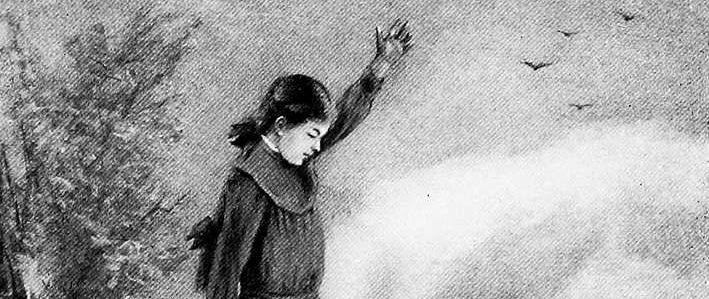The original autumn girl: Anne Shirley’s whimsical legacy
“I’m so glad I live in a world where there are Octobers” is plastered all over social media the moment the first of October strikes, used as the caption to photo carousels of pumpkins, hot drinks and falling leaves. L M Montgomery’s beloved heroine Anne Shirley’s ruminations on shedding leaves and changing routines have made Anne of Green Gables the quintessential Autumn read for the last hundred years. Its autumnal whimsy has been attempted to be recreated many times, most recently with the American sitcom Gilmore Girls, a show now almost inseparable from autumn to many TikTok users, who rewatch it every year. This romanticisation of autumn has persisted before and after Anne of Green Gables, but perhaps the explosion of social media has bolstered this glorified autumnal aesthetic.
Autumn has been a literary muse since the beginnings of literature, famously through classical mythology on the creation of the winter months. The tale of the goddess of harvest and fertility, Demeter, being so distraught by her daughter Persephone’s abduction by the God of the underworld, that she strips the trees bare and kills the flowers in her grief every year when her daughter returns to the underworld, is magnificently portrayed in Ovid’s Metamorphoses. With the explosion of mythological retellings following Madeline Miller’s The Song of Achilles, this story has been frequently reimagined, for example, by Bea Fitzgerald’s best-selling novel, Girl, Goddess, Queen. This reflects how Autumn’s magical quality continues to inspire both literature and culture.
An almost motherly quality is given to autumn
With the sometimes dangerous and always addictive access to social media, the cottage core trend has exploded as a whimsical, nostalgic escape from the media’s hyperreality. Romanticising autumn as a time of peace and idyllic country walks helps lessen the miserable turn from eternal sunshine to everlasting clouds. The sub-genre of ‘cosy fantasy’ highlights this, with slow fantasy novels, often with feel-good romance and happily-ever-afters, such as The Ex-Hex by Erin Stirling. Whilst some readers crave gothic horror in Autumn months, others prefer the heartwarming novels that emphasise a nostalgic autumn. Furthermore, books with a central spine of community, like Anne of Green Gables, and small-town romances like The Pumpkin Spice Café by Laurie Gilmore, are central to the autumnal reading aesthetic. When pub garden evenings in the summer sun dwindle, and instead we return, soaking wet, to our televisions and social media on blistering evenings, this nostalgic desire for a ‘small town’ or ‘found family’ escape in novels is a key component of the cottage core aesthetic. This is illustriously done within Anne of Green Gables, but more recently in The Very Secret Society of Irregular Witches by Sangu Mandanna, highlighting community and belonging during what can be a lonely and dark time of year.
Writers don’t, however, just use the autumn aesthetic to create a cosy, comfortable sensation for the reader, but also to highlight the almost paradoxical, beautiful melancholy of this liminal season.
The abundance of candles, slippers and fluffy scarves that line shop fronts and Pinterest feeds in late September and early October helps to self-mythologise this heavily aestheticised autumn. An almost motherly quality is given to autumn, with descriptions of decorated hearths and amber leaves trampled upon by the boots and dangling scarf-clad walkers drinking pumpkin-spiced drinks. This cottage-core linked aesthetic to an escape to life’s basics and traditions is also woven throughout autumn-inspired literature. The romantic poets are a clear example of this, rejecting industrial modernity for nature’s eternal beauty, such as Keats ‘To Autumn’, where the speaker self-reflects at the end of the year, with the falling leaves reflecting the shedding of a past self and decay. More recently, Carol Anne Duffy’s poetry is filled with autumnal metaphors to highlight discontentment, the death of romance and self-reflection. Writers don’t, however, just use the Autumn aesthetic to create a cosy, comfortable sensation for the reader, but also to highlight the almost paradoxical, beautiful melancholy of this liminal season. E.g., The Dead Poets Society’s utilisation of an autumn background to reflect the academic aesthetics and the underlying melancholy and growth of the protagonists, as they transition from innocent schoolboys to inspired young men. The switch from the warm sepia of the autumn months into the cold blue of the early winter reflects the sometimes overpoweringly depressing nature of autumn and the societal oppression the characters face. Sticking to Dark Academia media, The Secret History and even the Harry Potter Series have strong autumnal aesthetics, reflecting the new beginnings of school, the ending of the calendar year and the shedding of leaves, and thus this bittersweet mix fuels the mysterious yet comforting autumnal literary aesthetic.
The whimsical romanticisation of Autumn has also created an alternative to the frightening horror with cosy Halloween tales
It is impossible to write about the autumnal aesthetics without mentioning the dominance of Halloween in the autumnal months. Inspired by the pagan festival of Samhain, where it was believed the veil between the living and dead was weakened, and later the Eve of All Saints’ Day, Halloween has become the pinnacle of the gothic and horror lovers’ year. Autumn, therefore, becomes the backdrop for the gothic canon: Donna Tartt’s The Secret History, Bram Stoker’s Dracula, and Charlotte Brontë’s Jane Eyre. The whimsical romanticisation of autumn has also created an alternative to the frightening horror with cosy Halloween tales, such as The Very Secret Society of Irregular Witches by Sangu Mandanna and My Roommate is a Vampire by Jenna Levine.
Therefore, as the evenings grow darker and the conkers fall, let’s take a leaf out of Anne Shirley’s book and romanticise autumn to be a glorious month.

Comments